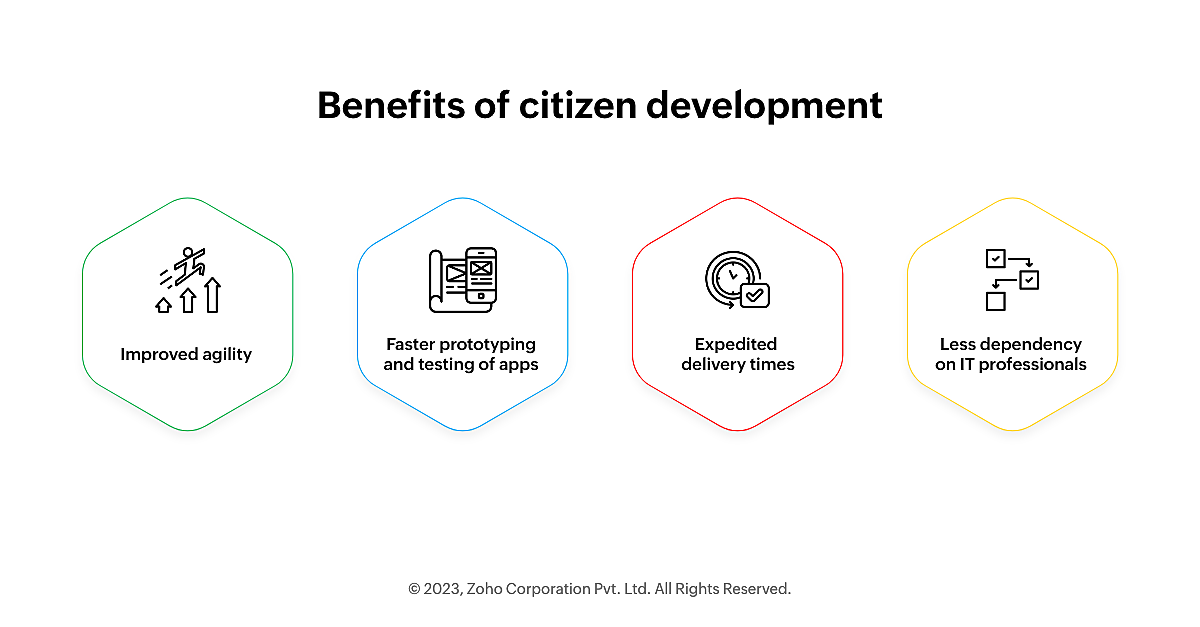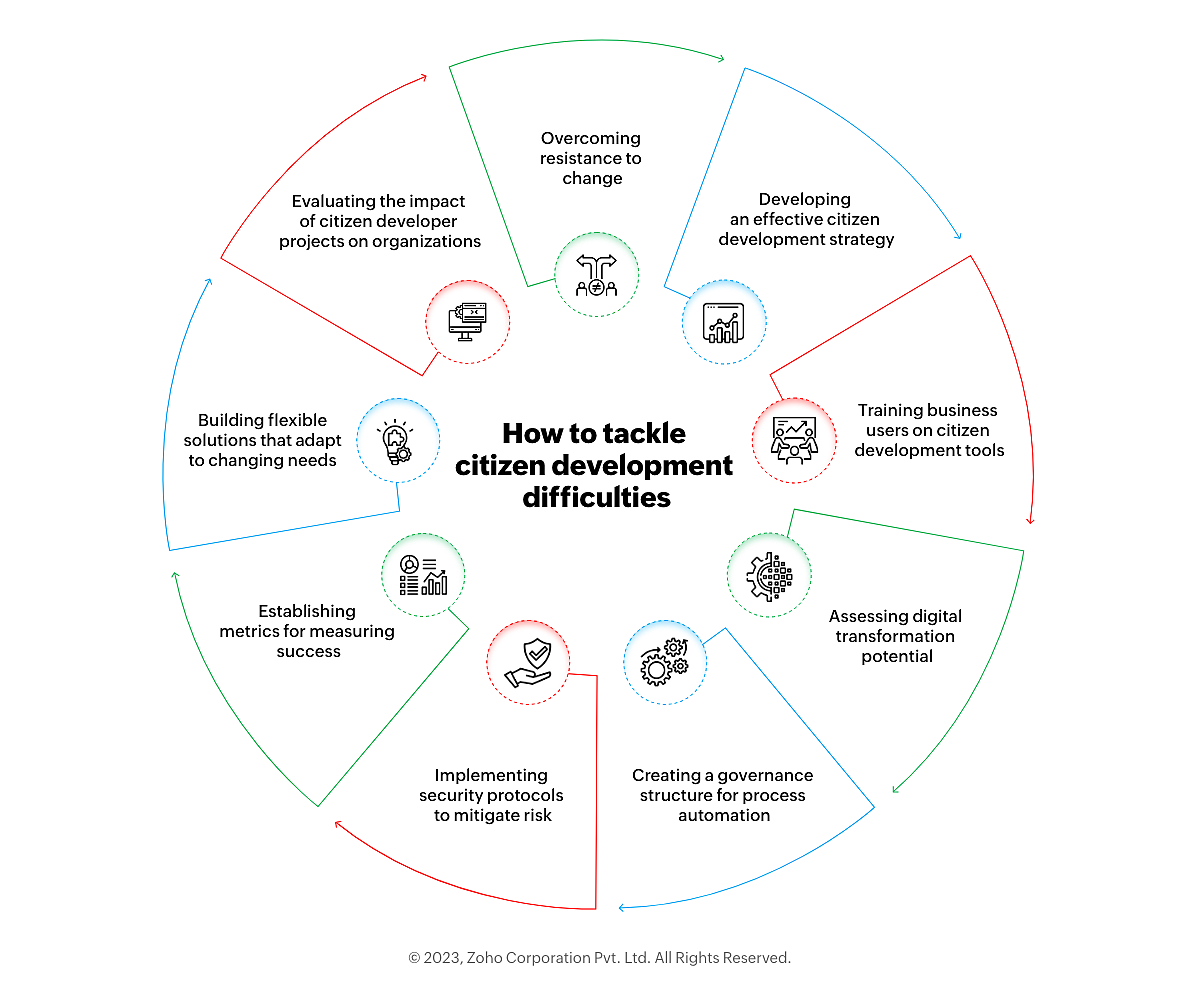- HOME
- Know Your Tech
- 9 key considerations when implementing a citizen development program
9 key considerations when implementing a citizen development program
- Last Updated : August 31, 2023
- 1.3K Views
- 11 Min Read
Businesses are increasingly turning to citizen development as a means of boosting process automation and digital transformation. This approach gives non-programmers, such as customers and employees, the opportunity to create their own applications for specific tasks. It also provides business units with the capability to rapidly make adjustments that fit customer preferences or business needs.
Even though there are many benefits associated with citizen development, these programs present businesses with certain difficulties. In this article, we'll discuss some of the issues organizations may encounter when implementing citizen development programs and how they can be effectively addressed.
Understanding citizen development and its benefits
When it comes to the digital evolution of organizations, citizen development is gaining prominence. This process involves equipping business experts, such as business analysts, to build apps on their own and automate business processes without depending on the IT department. The benefits for organizations include improved agility, faster prototyping and testing of apps, and expedited delivery times, plus less dependency on IT professionals.
However, establishing citizen development programs can be a challenge for many business units.

How to tackle citizen development difficulties
A common difficulty revolves around making sure all employees have the aptitude to work collaboratively with the appropriate tools.
There may be problems with governance and safety when allowing citizen developers to access sensitive data for application development. Therefore, it's essential that businesses recognize and manage the risks of user-generated content, while still empowering employees to become citizen developers.
Many organizations also struggle to find a balance between controlling application design and giving end users freedom to develop and deploy. It can be difficult to provide sufficient independence to citizen developers while maintaining authority over core components, such as data structures or system performance characteristics.
To tackle this problem, it can be helpful for organizations to explore solutions that allow them some degree of oversight, but provide business users autonomy when designing apps or automating more technically complex projects within a citizen development initiative.
One last obstacle comes from ensuring every stakeholder within an organization is aware of the endeavour and supports it before implementation begins, rather than seeing it as an unnecessary cost or risk.
For any initiative like this to succeed, everyone needs to understand its purpose. This means senior management must back its potential benefits and encourage buy-in from all levels of the organization.
1. Overcoming resistance to change
Organizations that seek to implement citizen development programs may face pushback when introducing this change. Disruption can be difficult, and it's essential to prepare for potential opposition at all levels. Staff affected by new technologies or procedures may worry about job security, while business leaders could worry about a decrease in authority if employees have more autonomy over projects. Executives might also reject any changes that involve extra expenses, such as IT infrastructure costs, operating costs, and training costs.
Business users who don't understand how citizen development works, or know about its advantages, can be another source of resistance. To limit opposition, organizations must have an executable strategy in place from the start, outlining the objectives and anticipated results of the system. They should also provide information on why citizen development can make business goals easier to achieve than traditional application development methods.
Fortunately, some stakeholders will likely accept these changes, as they'll understand that it's an opportunity for growth within the business. Companies should involve these supporters early on, and enlist their help in promoting a positive, rather than fearful, outlook around the changes.
It's important to remember, though, that no one can force someone else into adapting to something new. This is why support from senior management is essential throughout each step of the transition process. Employees should feel safe enough to tryout ideas without fear of failure or punishment if things don't go according to plan straight away.
2. Developing an effective citizen development strategy
Organizations may find themselves facing struggles when aiming to introduce citizen development. Crafting an effective plan for a citizen developer is essential for overcoming these issues. Citizen development involves giving non-experts access to tools that enable them to build apps, allowing organizations to develop customized business applications rapidly and inexpensively compared to traditional software development techniques. That being said, there are still challenges that they will need to address while employing this strategy.
One such challenge is making sure the established citizen development program meets the business objectives and needs. It's thus necessary for companies to provide clear guidelines and expectations regarding what should be included in each application, so both professional developers as well as citizen developers understand their responsibilities. In addition, it's important that requirements have been accurately documented, so any alterations or additions can be effortlessly implemented by any citizen developer or even a software developer without causing delays or disruption.
Businesses should also consider data security, as app created by citizen developers usually involve third-party instruments, which could pose potential risks if not managed properly. To reduce the likelihood of a security breach occurring, organizations must establish controls managing who has access to sensitive information, along with how it's shared internally and externally.
Encryption protocols must be employed before releasing any app into production environments, where safety could be jeopardized.
Supervising deployments across multiple platforms, including mobile devices or cloud computing systems (such as Amazon EC2 instances or Google Cloud Platform virtual machines (VMs)), may also be a hurdle. Ensuring consistent performance on all systems necessitates careful planning; therefore businesses must not only define acceptable performance criteria, but also devise strategies for assessing user experience during regular times versus peak hours, which can help detect areas requiring additional resources.
3. Training business users on citizen development tools
Citizen development tools give business users the power to become citizen developers, making it simpler and faster for them to automate a business process or develop end-to-end digital solutions. While this can be beneficial, there is a need to properly train staff on how graphical building tools work.
Training requires resources and personnel who understand the tool; in addition, new features or updates may necessitate more training every now and then, which could entail higher costs due to fees charged by external trainers.
If a citizen developer has difficulty using the tool correctly, there is a risk of lowered productivity and errors during application creation or delivery processes.
Therefore, introducing any new technology into an organization calls for a successful train-the-trainer program, centered around knowledge of the product being used, as well as teaching methods that include interactive activities with practical examples, so citizen developers can grasp concepts while having fun at the same time.
4. Assessing digital transformation potential
To improve operational efficiency, agility, and innovation through digital transformation initiatives, it's essential that organizations evaluate the potential of their current technology. This is especially true when implementing a citizen development program. Business users who are engaged in this type of development not only use, but also create, applications using existing technologies in new ways. To guarantee a successful outcome for any such venture, businesses must first assess what already exists and determine what needs to be done differently or better.
Evaluating the types of technology currently available is critical here—traditional software tools, like databases or web-based solutions, as well as more contemporary tools, such as artificial intelligence and machine learning, should all be taken into account with respect to how they can help the business reach its goals. For instance, artificial intelligence can provide insights into customer behavior, while machine learning makes automation (as opposed to manual input from employees/contractors) possible.
Once existing capabilities have been examined thoroughly, companies should move on to assessing their opportunities for digital transformation through citizen developer plans—determining whether the tech at hand will meet the project requirements and whether new tools, like low-code platforms, could provide faster or simpler means for reaching the objectives.
Finally, yet importantly, the culture within an organization plays a key role in determining whether change will be embraced quickly enough, so that success can be achieved within a reasonable timeframe. A thorough transition plan, which considers potential disruptions, helps businesses attain more ideal results from citizen development endeavors.
5. Creating a governance structure for process automation
Creating a governance structure is an important part of any citizen development endeavor. Without it, there can be difficulty ensuring software development initiatives are carried out correctly and proficiently. A well-defined governance model guarantees that all automated processes have been precisely defined, tried, and sanctioned by the IT department before being implemented into the organization's systems. Moreover, appropriate tests guarantee that automated processes are working as desired and generating expected outcomes.
For business process automation governance to be effective, it is critical to have unambiguous roles and obligations for all stakeholders involved in the task. The plan should unequivocally detail who will control the project, who will implement changes or modifications to existing procedures, who will monitor performance metrics and assess compliance issues pertaining to automation projects, and more. This ensures everyone understands their role within the business process, so they can collaborate fruitfully with other teams across the company.
A systematized plan for change management helps businesses make certain that any alterations or updates made during an automation project's lifecycle do not negatively affect other current business processes or systems. Change management should also include protocols for communication between one business unit and another, so they can efficiently coordinate their efforts, if needed, during an automation project's implementation phase or after its deployment into production environments.
It's critical for organizations introducing citizen development initiatives to evaluate existing IT infrastructure prior to commencing any new ventures involving process automation technology, like robotic process automations (RPA). This assessment should cover both present hardware abilities plus software compatibility issues, which must be attended to before starting any fresh RPA implementations.
Companies must consider IT security measures when deploying RPA solutions, since these often access sensitive data from corporate networks, which may necessitate authentication protocols beyond those already used by internal IT departments.
Lastly, organizations must budget for potential maintenance costs associated with RPA solutions, which could include developing customized integrations between diverse software applications, on top of basic system upkeep tasks, like patching servers.
6. Implementing security protocols to mitigate risk
With the adoption of citizen development on the rise, there's an ever-growing demand for business process management systems that can protect data from breaches and attacks. However, due to both the intricate nature of security protocols and the continuous evolution of threats, organizations need to be persistent in their efforts to make sure their networks remain safe from external intrusions. This necessitates a combination of preventative measures, such as installing patches and updating software regularly, and reactive steps, like responding quickly when an incident occurs.
Besides having a well-crafted security policy in place, companies must also ensure the policy's observance by all staff members through training and educational activities related to handling confidential information safely. Moreover, organizations should periodically review their policies and adjust them to keep up with changing risks or technologies.
Understanding different types of threats in order to protect against them properly presents another challenge for organizations setting up safety protocols. Although some risks may be reported by external sources, such as news reports or industry alerts, others can go undetected without proper monitoring tools installed throughout the organization's network.
Certain kinds of attacks require specialized knowledge or expertise to detect before any harm is done; this means investing in experienced personnel who are familiar with how these dangers operate, so they can take appropriate action if necessary.
Ensuring compliance with cybersecurity regulations can pose major issues for organizations looking to introduce citizen development, since these provisions vary depending on local laws about data protection and privacy rights.
7. Establishing metrics for measuring success
With the continuing rise of automation, organizations must create their own application development frameworks to stay ahead of the competition. Low-code development tools help employees to create applications and workflow automations tailored to specific needs. But the process can be complicated if there isn't a plan set out from the start.
It's essential for firms to specify objectives and metrics which show how successful they are at incorporating citizen development initiatives into their business. Objectives should be measurable, such as the number of developed or improved applications, degree to which operational efficiency is improved by automation, number by which customer satisfaction ratings increase, or amount by which expenses related to manual processes are reduced. Moreover, these goals must be achievable over an appropriate timeframe and monitored closely, so progress can be tracked leading up to completion or improvement of current business processes/apps.
Before pushing any changes into production environments, it's important for companies to understand what benefits they'll gain from citizen developers; this includes understanding user feedback on existing systems, plus testing new features prior to deployment into live operations. Without an established baseline, it can prove difficult for IT teams (or external consultants) to measure performance improvements accurately over time.
For any citizen development initiative to succeed, stakeholders across the business need assurances that proposed modifications offer actual advantages when compared with pre-existing procedures and systems. Otherwise, resistance can arise, lowering acceptance rates and consequently impacting the overall success metrics laid out at the commencement of the project or initiative.
8. Building flexible solutions that adapt to changing needs
Organizations often face many challenges when implementing citizen development programs. One of the most significant and important is creating solutions that can be adjusted to meet changing needs. Citizen development projects are intended to give users the capability to make their own apps, while bypassing IT departments and conventional software developers. This means organizations must be able to create, upgrade, and maintain customized business applications for each user as their needs inevitably change.
To guarantee that citizen developers get the tools they need, organizations should focus on laying a powerful foundation for managing multiple forms of code in production settings. Version control systems enable users to easily track any changes and permit engineers to store a duplicate of all earlier versions, just in case there are problems with the current version. These systems also includes an audit trail, which helps organizations track down mistakes or security-related concerns more quickly, if they emerge down the line.
Organizations also need to consider investing in automated testing tools, which can be used by both IT departments and citizen developers when making changes or adding new features or functionality. By running a series of automated tests on every release before it's made accessible for general use, businesses ensure that no new bugs are added during deployment cycles.
Finally, companies should look into building frameworks which allow easy extensibility, so citizens developers can incorporate additional components at any point, without having too much difficulty integrating them with existing code. This saves time, while giving clients adaptability when it comes time to expand existing applications.
9. Evaluating the impact of citizen developer projects on organizations
While citizen development can be a boon for organizations, there are also some hurdles that need to be overcome.
Without appropriate boundaries, governance, and procedures in place, companies may struggle to ensure conformity with applicable data security regulations and guidelines. This can result in security risks, should an application contain sensitive information or be used by several departments within the organization.
Another challenge connected to citizen development is troubleshooting problems when they arise, due to inexperienced personnel creating their own apps. In such cases, IT professionals may require supplemental training on handling these types of issues, so they don't cause any disruptions within the company or with its business process.

Citizen developers
Modern enterprises must carefully consider the pros and cons of employing citizen development initiatives. From streamlining operations to advancing digital transformation goals, organizations can gain a great deal by properly deploying these programs. To make sure they're successful in their implementation efforts, companies should thoroughly assess their current environment, devise an action plan, and build strategies that will help them seize the opportunities offered by citizen development. By taking preemptive measures and bearing potential risks in mind, businesses can successfully deploy projects that will be advantageous for employees and customers alike.
 Pranesh
PraneshPranesh is a serial entrepreneur and the Founder of Studio 31, a 12 year old, deep tech enabled, wedding photography and film company that has been recognized by many publications for its zero inventory model and unique culture in the unorganised sector.
Zoho Creator has helped Studio 31 redefine its business model by automating over 37 processes and save three hours every single day. He is also a growth consultant for Zoho Creator and helps the team address real-world challenges from a customer's point of view.



